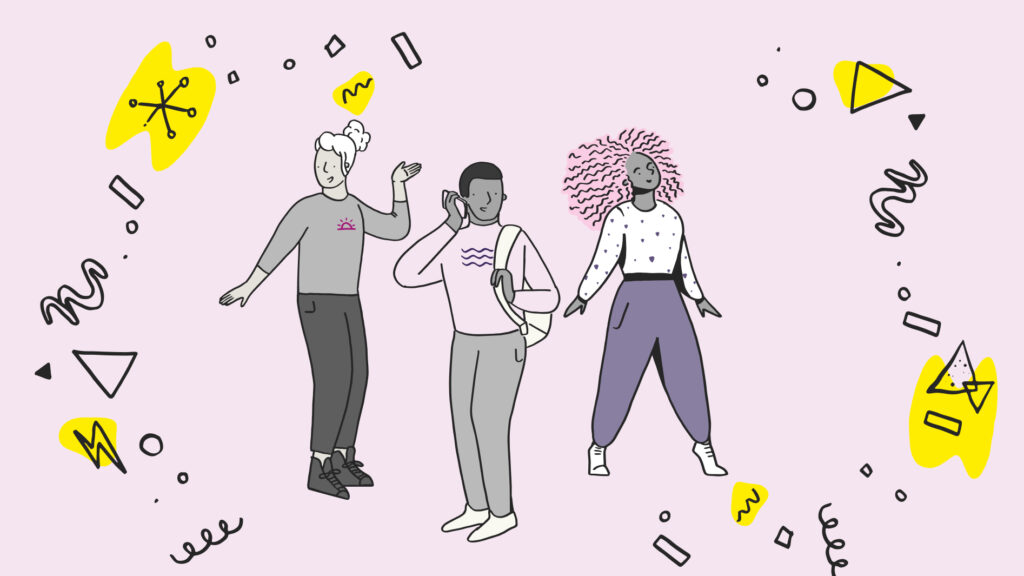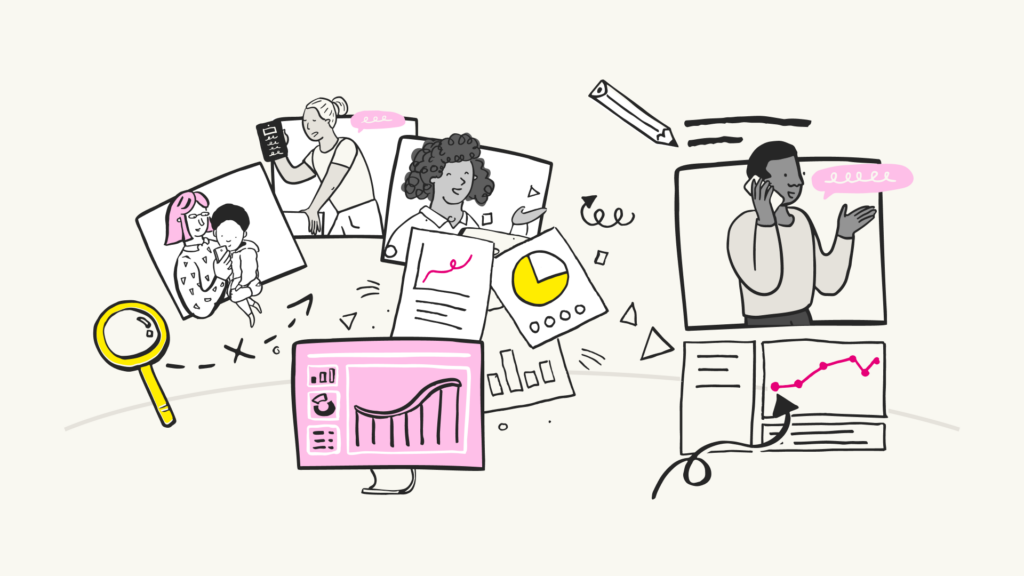
As UX researchers, our work directly impacts how products and services are shaped and inclusive design starts with the way we conduct our research activities. User research is a key step where we can ensure users are involved in designing an experience for them. And we mean all of them.
When we talk about conducting inclusive research, this comes as a big multifaceted topic and might sound overwhelming. You might not know where to start. The good news is you don’t have to relearn your methods – just shift your mindset.
Yes, you will still be a researcher after reading this article. But with a different outlook on how to be inclusive to all users of a product or service.
Here are 12 tips to help you make your user research practice more inclusive.
1. Recognise existing biases
Our brain is designed for streamline thinking so we can make sense of the world. In the process, we perform quick judgments unconsciously. That’s where our biases come from.
We all have biases in our personal and professional life, and it’s okay to recognise that. The best way to work with our biases is to put them out in the world so we can be aware of them. This could be as simple as writing down your own thoughts and beliefs about a topic.
You could also create space for you and your team to talk through thoughts, beliefs, experiences, questions, and unknowns. Once we are aware of our biases, we can reflect and learn to adjust our thinking to be more mindful in our research.
2. Gather the facts and assumptions from your stakeholders
Similar to how our mind builds its own biases, with time, project teams and organisations are often built on assumptions that, in turn, are treated as common knowledge. Gather all the facts and assumptions from your stakeholders as well as yourself and team about the target audience.
Yet, the process shouldn’t stop at acknowledging these assumptions; instead, it should evolve into a proactive approach that shapes your research strategy. One effective approach is initiating your research within a workshop. This setting provides a unique opportunity to bring together diverse perspectives, expertise, and experiences. By starting your research with a workshop you can include assumption mapping exercises, and facilitate the unravelling of hidden biases and the rigorous examination of unverified beliefs from your stakeholders.
It is always helpful to write everything down. Validating what we think is evidence-backed and what we assume to be true that needs verifying. There are plenty of assumption mapping exercises we can perform in a workshop. Once listed, assumptions can feed a research backlog and help build learning.
When stakeholders, colleagues or subject matter experts state facts or numbers, ask for the source reference. This will reinforce confidence in what is supported by previous studies and prevent any fact distortion effects.
Fact distortion effects: information that is distorted as it’s passed down from one person to another. (I am trying to avoid using the “telephone game”)
3. Create a shift of mindset within your organisation
UX researchers cannot tackle the diversity and inclusivity challenges in design alone. We need to work with the organisation and systems around us to make an impact.
To shift the mindset of how we can make research more inclusive, we need to start by asking “who are we currently excluding and why?”
Everyone that makes decisions that impact the solutions we build has an impact on how inclusive the solution can be. For this reason, it is worth opening the conversation to others in our organisation. Starting a conversation about where we are today can help us reflect and see the bigger picture.
4. Embed inclusive research early on and throughout the project
Embed inclusive research as early as possible and throughout your projects to ensure the best impact. Involving a diverse range of users early on means building a better and deeper understanding of who your audience is and what are their wants and needs.
Those insights can drastically change how a product or service is planned and designed. Hence their importance at the early stage of a project.
Let’s not forget that decisions are made daily when shaping a solution with our audience in mind. Doing research in the discovery phase and validation at the design stage is good, but it’s important to double-check when we stop drawing from user insights and start putting our assumptions back into our work.
It is important to keep the conversation open with our audience. Are we writing user stories with underrepresented groups in mind? Have we tested all features with people with special needs? When was the last time we talked with users from minority groups? Keep asking those types of questions.
5. Shift how you frame your audience
The way we sample participants to do our research matters as it impacts what we find today and can shape how we frame our assumptions as we move forward on a project.
How we frame our audience may be inclusive or exclusive, which makes this an essential step towards fairer representation in our research.
Map your audience and see who might be excluded. It is always healthy to talk to people outside of your project or organisation to gain different perspectives on what might be missing.
6. Be strategic with your participant sampling
It is difficult and costly to involve everyone in every single study we do. It is also hard to justify increasing the research budget just for the sake of inclusivity. Projects don’t have an infinite budget and time allocated to research, and project teams need momentum to deliver results. Therefore we need to be strategic with how we decide on participant sampling.
Let’s not think about the one study we must do now but all the research work we do throughout the project. If we can’t have every participant’s profile represented in each study, let’s see how we can ensure we have a fair representation across all of them.
Make sure you keep track of the type of participants that are involved in each study and adjust the recruitment for the subsequent ones. Be picky with the research methods you choose and how participants are recruited. Guerilla research and third party recruitment platforms are convenient but ask yourself who is being excluded in the process.
7. Use inclusive tools and methods
The range of tools and methods available to do research has expanded rapidly, but not all of them are accessible to all audiences. Make sure you assess the tools and methods your team uses objectively and understand who might not be able to participate in your study because of those tools. The range of tools and methods available to do research has expanded rapidly, but not all of them are accessible to all audiences. Make sure you assess the tools and methods your team uses objectively and understand who might not be able to participate in your study because of those tools. If you’re interested in understanding how accessibility can have a significant impact, check out our blog on the commercial impact of accessibility.
People’s needs and barriers to participation come in all shapes. We often think about digital accessibility needs in this context, but we should also consider other factors, such as availability to participate in studies and language or technology access barriers.
Tools and methods are not fitted for all audiences or projects, so list down alternative solutions. Having alternatives ready will remove any friction from doing the right thing for our participants.
8. Provide options to the participants
As we mentioned before, because tools and methods are not fitted for all audiences, we need provide other options where possible. Participants’ needs can be different from one person to another.
Providing options at each step for the participant is involved is a good way to mitigate the chances for people with the most challenges to drop out of the study. This will benefit more than underrepresented people because it will give a chance for all participants to be more at ease with the study.
This could be as simple as providing the option to:
- have a paper or translated consent form
- have an interview via phone, Zoom call or in person
- bring someone with them for support
- offer an alternative of how to be compensated for the study
9. Plan ahead and be ready to adapt
Working with a more diverse audience means adapting how we do research around the participants. Plan and be ready to adapt to the unexpected. Allocate more time when the need arises. If there is a need for a translator, factor in the time of the translation for both the question, answer and clarification.
Plan ahead when testing with assistive technology. If using the participant set up, you might realise right before the session that a blind person might not have a screen or mouse to use your digital solution. You might need to bring a screen to follow along.
When using your own set-up, allow time for the participant if needing to adjust settings to their needs or get used to the settings in place.
10. Be kind and patient with yourself and others
It is okay to be nervous about faux pas when entering a session with a non-native speaker, a non-binary person or someone with a disability we don’t know much about. Remember to acknowledge that with the participant while ensuring that you are both feeling safe and comfortable with the session.
We can get nervous about using words that we think might feel condescending, hurtful or disrespectful. Breathe in and remember that you are a human being having an exchange with another human being.
Take the time to build a relationship and take some pauses within the conversation if it’s needed. You might realise that the person in front of you is using the words you felt were taboo.
11. Be curious about diversity
There are many dimensions to cover when talking about diversity, and we keep on learning as a society how to celebrate them. It’s a great time to be curious about this topic.
There are plenty of resources, talks, organisations and forums on the topic of diversity, inclusive design and universal design.
Invest time to talk with people you would often not socialise with, be curious and learn about people from all walks of life.
12. Accept this as a journey
We don’t get everything right or perfect the first time, and that’s okay. Learn and iterate as you go along. Today, you might be learning more about gender diversity and ethnicity and tomorrow, you might be able to tackle neurodiversity and build a more inclusive research practice on that point.
It is more important to continue building knowledge as you go, as this is what research is all about.
Inclusive research at Nomensa
Do you need help with inclusive research? We’ve been performing user research for over 20 years and have custom made labs in our Bristol office specifically for running research with people with disabilities.
We’re well versed in facilitating sessions with underrepresented audiences, vulnerable people and people with special needs. We have extensive contacts for recruiting participants and have over two decades of digital accessibility expertise.
Contact one of our team today us to find out how we can help you.
We drive commercial value for our clients by creating experiences that engage and delight the people they touch.
Email us:
hello@nomensa.com
Call us:
+44 (0) 117 929 7333




